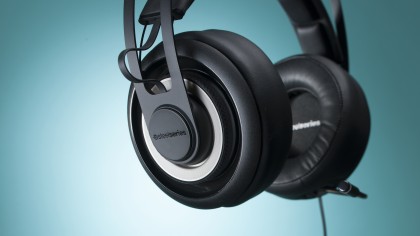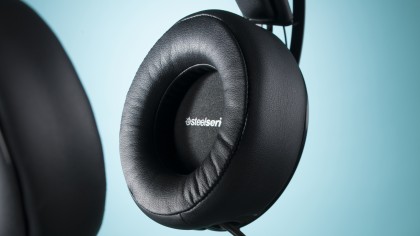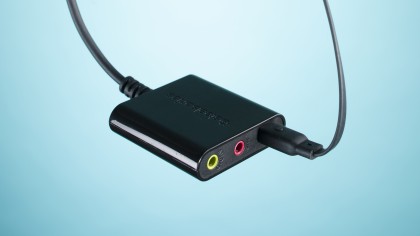TechRadar Verdict
For gamers coming from the SteelSeries V2, the Elite Prism is a serious upgrade. FPS savants and budget buyers, however, are best served looking somewhere else.
Pros
- +
Cosy padding
- +
Easy setup
- +
Rock-solid hardware
- +
Awesome extras
Cons
- -
Comically large earcups
- -
Poor surround sound
- -
Audio takes tweaking
Why you can trust TechRadar
I have, in my possession, far too many headsets. I use the Beats Studio Wireless for music around the house. But, when I turn on a console, it's all about the latest set from Turtle Beach. And when I'm strolling around San Francisco, it's the Astro A38s – despite their lack of a 3.5mm jack.
No matter how cool these cans are today, I doubt I'll be wearing all of them come this time next year. The gaming headsets that have been through hell and back, though, are my SteelSeries Siberia V2 and almost-unrivaled Razer Kraken. They're comfortable, sound great and take next to no work to set up.
The other benefit of the V2 is that they're wildly inexpensive. SteelSeries is officially setting them out to pasture, but before they do, you can easily snag a pair for $89 (about £55, AU$100).

The latest headset from SteelSeries, the Siberia Elite Prism, is a lot like its predecessor. It's comfortable, sounds good, takes no work to set up. These cans are different in the sense that, objectively speaking, they look absolutely awkward when set atop anyone's head. And forget about that $90 price tag: the Elite Prism will run you $199 (about £120, AU$230).
Design
Setting aside the "awkward" comment for a moment – don't worry, it will come up again – the Prism Elite is actually quite well constructed.
The bridge consists of two steel bands that serve as a brace for the extendible foam padding. While the two steel bands are a staple of the Siberia line of products, the padding, at least, is reminiscent of the SteelSeries H Wireless that we took a crack at earlier this year.
The bridge connects two oversized earcups. Despite being more comfortable than the previous SteelSeries Siberia V2, they aren't the most aesthetically pleasing. This may not matter for a secluded gaming session. But bring these to a LAN, tournament or wear them during a Twitch stream and they might make you look a little … to put it politely, ridiculous.

Instead of opting for an in-line control unit for volume up and down, the LED on the right earpad rotates to raise or lower the sound. The left LED rotates as well but opposed to volume, mutes and unmutes the retractable mic hidden away inside the left earcup.
These features are smart, work well and look even better. The glowing LEDs can be set to a rotating pattern or stuck on one solid color and with 16.8 million colors to choose from, you'll never run out of options.
Sound and mic quality
At the risk of sounding like a broken record: Most headphones can't do true surround sound. Surround sound, by definition, requires "a system of stereophonic sound involving three or more speakers surrounding the listener so as to create a more realistic effect."
As a two-driver headset, the SteelSeries Prism can't actually offer true Dolby Surround Sound. What it can offer, though, is Dolby Pro Logic sound. Enabling this option in SteelSeries's Engine 3 customization software makes a more complex, full audio output, but it's not – by any stretch of the imagination – "true" surround sound. I used the set to play Call of Duty: Black Ops and Counter Strike: Source and both times the surround sound didn't provide strong directional audio cues.
And that's not to say the headset sounds bad on its own. It doesn't. I found the Elite Prism more than adequate for my day-to-day gaming needs. You can, however, get an even better sound for, say, movies or music, by poking around inside the aforementioned software. Once you get the levels just right, you can make the Prism's sound truly boom.
Mic quality, on the other hand, is solid from start to finish. I nary heard a complaint from the party on the other end of line about the sound quality. Plus, I always knew when I was unmuted during a match, thanks to the responsive white LED on the tip of the mic.

It's the little things in life
If SteelSeries would've stopped at the simulated surround sound, hideaway mic, and strong-but-awkward build quality, the Prism would've been almost identical to every other pair of cans from Plantronics, Razer, Logitech and Corsair.
What makes this pair unique, however, are the minute details: the flat, no-tangle cord, customizable LED lighting and 3.5mm headphone jack that's built into the right earcup.
The latter lets a buddy or significant other connect another pair of headphones and listen in without a splitter. It's an incredibly simple, common-sense addition, but goes to show SteelSeries is putting a lot of thought into the extras on this pair of cans.
Another addition I really liked was the inclusion of a four-foot extension cord and mobile phone connector right in the box. You'll likely use the USB soundcard when you're connected to your PC or Mac – that's what provides the simulated surround sound after all – but it's nice to have the options to take this set with you when there isn't another pair of more (ahem) "street appropriate," headphones laying around.
Verdict
The Elite Prism are overall a functionally solid pair of headphones. They sound deep and rich, dissipate heat fantastically well and do a great job transmitting voice in the heat of battle.
That said, they're not perfect. The biggest flaws are the feeble surround sound, and a design that, honestly, makes you look like you're an old-school DJ about to play "Jump On It!"
If you're a diehard SteelSeries V2 user, the Elite Prism is a worthwhile upgrade for its improved comfort and USB sound card. The average gamer, however, should wait for next year's imminent aesthetic upgrade or – supposing money is no object – opt for the Elite Prism's older brother, the H Wireless.
Nick Pino is Managing Editor, TV and AV for TechRadar's sister site, Tom's Guide. Previously, he was the Senior Editor of Home Entertainment at TechRadar, covering TVs, headphones, speakers, video games, VR and streaming devices. He's also written for GamesRadar+, Official Xbox Magazine, PC Gamer and other outlets over the last decade, and he has a degree in computer science he's not using if anyone wants it.

